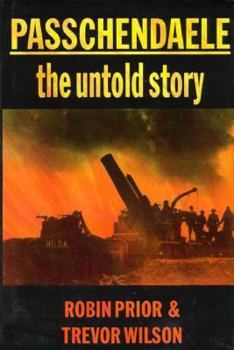Passchendaele: The Untold Story
Select Format
Select Condition 
Book Overview
No conflict of the Great War excites stronger emotions than the war in Flanders in the autumn of 1917, and no name better encapsulates the horror and apparent futility of the Western Front than... This description may be from another edition of this product.
Format:Hardcover
Language:English
ISBN:0300066929
ISBN13:9780300066920
Release Date:July 1996
Publisher:Yale University Press
Length:237 Pages
Weight:1.54 lbs.
Dimensions:1.1" x 6.4" x 9.5"
Customer Reviews
4 ratings
Third Ypres Strategy
Published by Thriftbooks.com User , 16 years ago
This book is an excellent account of the battles of the Third Ypres campaign, the strategy and politics surrounding it. The book provides a balanced view of options, causes and effects present before during and after the campaign. It is a must for historians and serious WW1 buffs. I must stress that this book is very much on a macro level and focusses on battles and campaigns at an Army, Corps and Divisional level. It rarely gets below Division except to point out the difficulties being faced by soldiers. It is not a front line personal account but a well detailed history of the campaign. Personally, I think these authors were too easy on Haig. A commander that has five divisions of cavalry just behind the front, ready for a breakthrough to cross a No Man's Land on horseback in mud men could barely stand in. Five divisions going nowhere, consuming rations, wasting logistics. Haig had much to answer for.
Very Accurate and Very Dry
Published by Thriftbooks.com User , 18 years ago
This book was not written to entertain. I has all the excitement of a coroner's report. Having said that, Pryor and Wilson have, in my opinion, established themselves as the pre-eminent historians on the actions of the Western Front of WW1. The military history is liberally interlaced with British, and to a lesser extent, German home-front politics surrounding the battle. Much of this narrative revolves around the mutual dislike of Lloyd George (PM) and Haig, who was usually misinformed or misleading about the successes of the BEF in Flanders. The military aspect of the battle is told in a very matter-of-fact style, beginning with a description of the minor BEF successes at Vimy and Messines. The main battle then begins and the German defense system initially proves impenetable. General Plumer learns to compensate for the flexible German defense to some degree, but the weather then intervenes and a smaller but more competently led German army exacts its toll on the British. Wilson and Pryor estimate respective casualties at 200,000 German and 325,000 Allied. Inerestingly, Ernst Junger describes his experiences in this battle as a company commander as not a coordinated series of actions but a completely disjointed melee of confusion and isolation without benefit of support from the high command.
outstanding
Published by Thriftbooks.com User , 24 years ago
There"s not to much to add from the other reviews I think. This is a highly readable book. Much can be said of a operation that lasted 3 months at such a terrible cost and then give up what you gained in only 3 days! The book also points the finger of blame not just on Plummer, Haig, and Gough but also the war cabinat overseen by Loyd George and Robertson. A must read for those who never understood the campaigne.
Eye opener, Highly readable and top notch scholarship
Published by Thriftbooks.com User , 24 years ago
Unlike the usual dross (though still readable) that many WWI history books are like, this is an amazingly good book.The authors have obviously done their background work using the primary sources to an extent that to the reader, they convincingly break several WWI myths as routinely stated in many WWI history books.The first being about Battles of Attrition; making it clear the aims of the Generals in the various battles had solid strategic objectives that they were trying to gain. The Attrition excuse being made after the event to try and make a failed battle sound like a victory of sorts.Tanks were not a war winning weapon in WWI, but of importance for supporting the infantry (tanks being highly vunerable to artillary. The argument by the authors is that artillary was the WWI winning weapon on the Western Front.The main eye opener (for me at least) was the primary importance of artillary and evolving role and technology of the artilliary which had developed (high accuracy continuous correction shelling, counter battery, creeping barrage) to the point by 1917 that potentially, the British could break the German lines on the Western Front to a limited extend, and with limited casualties. However the hankering by Haig for a Breakthrough (and continous belief that one more push would demolish the morale of the German Army) helped lead "inadvertantly" to another attrition style battle.Overall, well worth buying and hopefully setting the standard that future WWI histories will be written to.






